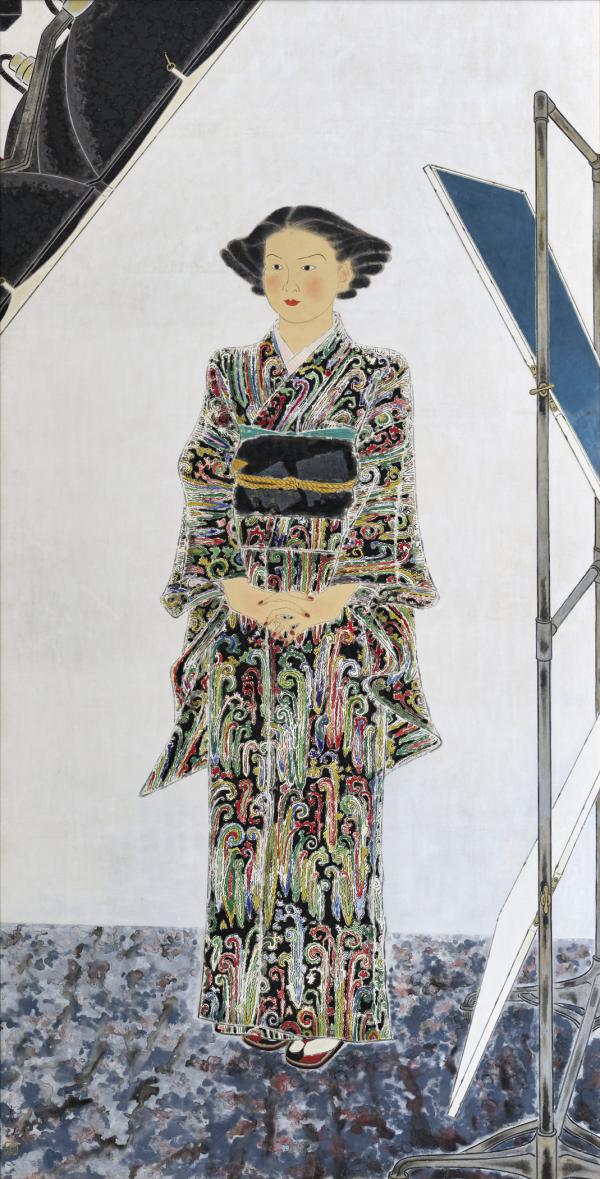Saeki Shunkō, born Saeki Toshio in Toyama Prefecture, left home at 15 for Tokyo to study art with Tsukahara Reizan (b. 1840). At age 18, Shunkō began working as a designer for the upscale Shirokiya Department Store in Tokyo’s fashionable Nihonbashi district. His textile designs garnered awards in juried design exhibitions. In 1926, he had a painting accepted by the prestigious Teiten exhibition. When he was 20, he continued his studies under the tutelage of Itō Shinsui (1898–1972), a well-known painter in Japanese-style painting (nihonga) and woodblock printing (ukiyo-e), exhibiting with the master’s atelier group, Rōhōgajuku (Bright Peak Painting Academy). In the 1930s, Shunkō’s paintings were accepted in three Imperial Academy of Arts exhibitions (Teiten, Bunten, Shin-Bunten), winning a prize at each exhibition. The art collector Hosokawa Rikizō (1889–1945), attracted to Shunkō’s intermingling of traditional Japanese and modern Western art materials, techniques, and motifs, purchased Photo Studio, shown in 1937 at a Rōhōgajuku exhibition.
Photo Studio references traditional Japanese-style paintings of beautiful women (bijinga) but in a modern way. With hands clasped, the kimono-clad life-size figure stands demurely amid professional photo lighting equipment; single lines of ink typical of nihonga practice define her face and hands. Her hairdo mimics the Tōrōbin Shimada hairstyle, inspired by the umbrella-shaped top of tōrō stone lanterns, popular during the Edo period (1615–1868). Instead of hair wax and tortoise-shell or baleen hair pins, a Western-style “stacked perm” technique created the extreme silhouette. Hair and make-up, including bright red fingernail polish, distinguish the model as a trendsetting urban middle-class working “modern girl” (moga), at ease in both Japanese and Western fashion modes. Her colorful kimono with long hanging sleeves (furisode) identifies her as unmarried. Its all-over pattern of bracken or fiddlehead ferns (warabi), an edible mountain vegetable forged in the wild, suggests that the photo session occurred in early spring. The fern motif also suggests the “Sawarabi” (Early Fiddlehead Ferns) chapter in the 11th-century classic novel The Tale of Genji.
Traditional dyed and embroidered silk kimono designs referencing seasons and scenes from classical literature have been popular for centuries. The modern kimono in Photo Studio was tailored from a contemporary textile known as meisen, which owes much of its existence to Western technology. Machine-reeled silk threads printed with colorful synthetically dyed patterns before being woven into cloth resulted in vivid ikat-like designs with blurry edges. Shunkō’s hand-painted squiggly ink lines outlining the multicolored fern-stalk motif on the kimono in Photo Studio likely depict meisen fabric fashionable in the 1930s.
When examined and decoded, Photo Studio reveals the fusion of tradition and modernity in Japanese art, fashion, and culture during the early 20th century.
During our 38th annual Collectors Committee Weekend (April 27–28, 2024), members of LACMA's Collectors Committee generously helped the museum acquire 10 works of art spanning a breadth of eras and cultures. Read more about all the acquisitions.



